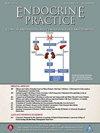1型和2型糖尿病患者糖尿病酮症酸中毒的结局和医疗保健利用差异:一项为期6年的全国回顾性队列研究
IF 4.6
3区 医学
Q2 ENDOCRINOLOGY & METABOLISM
引用次数: 0
摘要
目的:糖尿病酮症酸中毒(DKA)是卫生保健系统的一个重大负担。糖尿病类型对DKA结果的影响尚不清楚。本研究旨在比较1型(T1DM)和2型糖尿病(T2DM)合并DKA住院患者的死亡率、住院时间(LOS)和住院费用。方法:我们使用2016-2021年国家住院患者样本医疗成本和利用项目数据库的数据进行了一项回顾性队列研究,重点研究了诊断为DKA的急性护理患者。患者被分为两组:T1DM和T2DM。主要终点是死亡率,采用多元逻辑回归进行评估。次要终点包括LOS和医院总收费,使用多元线性回归进行分析,调整潜在混杂因素。多重输入解释了缺失数据,并对多重比较应用了Bonferroni校正。结果:共纳入1 24184例患者,其中T1DM患者770 109例(62%),T2DM患者474 075例(38%)。T2DM患者的死亡率(0.91%)明显高于T1DM患者(0.22%;P < 0.001)。T2DM患者的LOS较长(平均3.92天,而T1DM患者为3.02天;P < 0.001),医院收费也是如此(T2DM为10146.78美元,T1DM为7811.98美元;P < 0.001)。人口统计学和医院特征也存在显著差异,包括家庭收入中位数、保险类型和医院区域。结论:在这项全国回顾性队列研究中,T2DM和DKA患者比T1DM患者有更高的死亡率、更长的LOS和更高的医疗费用。这些发现强调了关键的差异,可能指导未来的干预措施,以改善T2DM患者的DKA结果。本文章由计算机程序翻译,如有差异,请以英文原文为准。
Disparities in Outcomes and Health Care Utilization for Diabetic Ketoacidosis Among Patients With Type 1 and Type 2 Diabetes Mellitus: A 6-Year National Retrospective Cohort Study
Objective
Diabetic ketoacidosis (DKA) represents a significant burden on the health care system. The impact of diabetes type on DKA outcomes remains unclear. This study aims to compare mortality, length of stay (LOS), and hospital costs between patients with type 1 (T1DM) and type 2 diabetes mellitus (T2DM) hospitalized with DKA.
Methods
We conducted a retrospective cohort study using data from the 2016-2021 National Inpatient Sample Healthcare Cost and Utilization Project database, focusing on patients admitted for acute care with a diagnosis of DKA. Patients were categorized into 2 cohorts: T1DM versus T2DM. The primary end point was mortality, assessed using multiple logistic regression. Secondary end points included LOS and total hospital charges, analyzed using multiple linear regression, adjusting for potential confounders. Multiple imputations accounted for missing data, and a Bonferroni correction was applied for multiple comparisons.
Results
The study included 1 244 184 patients, with 770 109 (62%) T1DM and 474 075 (38%) T2DM. Mortality was significantly higher in patients with T2DM (0.91%) compared to patients with T1DM (0.22%; P < .001). LOS was longer for patients with T2DM (average 3.92 days vs 3.02 days for T1DM; P < .001), as were hospital charges ($10 146.78 for T2DM vs $7811.98 for T1DM; P < .001). Significant disparities were also observed in the demographic and hospital characteristics, including median household income, insurance type, and hospital region.
Conclusion
In this national retrospective cohort study, patients with T2DM and DKA had higher mortality rates, longer LOS, and higher health care costs than those with T1DM. These findings highlight critical disparities that may guide future interventions to improve DKA outcomes in patients with T2DM.
求助全文
通过发布文献求助,成功后即可免费获取论文全文。
去求助
来源期刊

Endocrine Practice
ENDOCRINOLOGY & METABOLISM-
CiteScore
7.60
自引率
2.40%
发文量
546
审稿时长
41 days
期刊介绍:
Endocrine Practice (ISSN: 1530-891X), a peer-reviewed journal published twelve times a year, is the official journal of the American Association of Clinical Endocrinologists (AACE). The primary mission of Endocrine Practice is to enhance the health care of patients with endocrine diseases through continuing education of practicing endocrinologists.
 求助内容:
求助内容: 应助结果提醒方式:
应助结果提醒方式:


